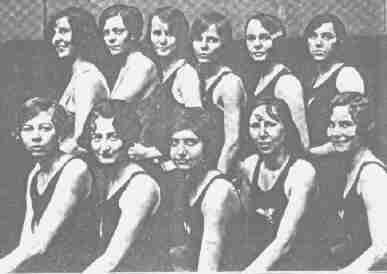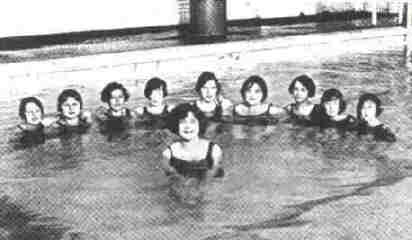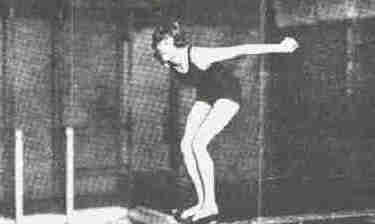Girls Interscholastic Swimming
in the Chicago Public Schools, 1917-1934
By ROBERT PRUTER
The decades long ban in Illinois on interscholastic competition for girls looked utterly archaic by the early 1970s, as it did in the rest of the nation. Particularly, if one looks at swimming, in which amateur clubs nationwide had been sponsoring for years flourishing age-group programs for girls as well as boys. High school-age girl swimmers were competing in the Olympics and national and international competition, but in Illinois and most states they could not compete for their own high schools. The barriers rapidly disappeared in the early 1970s, as the Illinois High School Association (IHSA) to its credit aggressively adopted a full-fledged interscholastic program for girls. Swimming was one of the earliest competitions in which the IHSA sponsored a state meet, in 1973. Maine South (Park Ridge) won the inaugural meet.
The Illinois High School Association (before 1940 the Illinois High School Athletic Association) for all its history prior to 1973 never permitted interscholastic competition in swimming. But competitive interschool swimming by girls in earlier decades was not completely unknown. Before 1926, the Chicago schools were not members of the IHSAA were not thus legally beholden to its strictures. It is among these schools where interscholastic swimming by girls took root.
Hyde Park High, which pioneered many sports in the Chicago schools, initiated girls swimming during World War I. The school was energized to form a team in 1916, after the Amateur Athletic Union (AAU), following a long ban, officially approved of swimming racing and diving contests for women. In big cities across the country, private clubs almost immediately began swimming programs for girls and women. In Chicago, the first private clubs to form girls' teams were predominantly Jewish clubs, notably Sinai Social Center and Chicago Hebrew Institute. Hyde Park High decided that it would form a girls' team to compete against these private clubs, and meets were arranged. In May 1916 the school beat Sinai Social Club in a dual meet, and the following year, in March, Hyde Park High bested three other clubs in an Amateur Athletic Federation (AAF) meet—Chicago Hebrew Institute, Sinai Social Center, and Butler House. The 1917 yearbook mentions that the team had difficulty arranging meets, lamenting that no other high school in the city had a girls' team. By 1918, Hyde Park High was forced into performing in public in "exhibition" matches among themselves. The swim team also had to severely cut down on its time in the pool that year because of the lack of coal that left the tank room and pool unheated.
By the 1920s, swimming for girls was banned by the Chicago Public High School League, as it did for most sports for girls, deeming interscholastic competition unsuitable and too stressful for the league's female students. Despite this ban, however, during the decade some of the league's high schools succeeded in engaging their girls in interscholastic swimming contests. These contests apparently emerged, ironically, as a result of the rapid growth in the early 1920s of Girls Athletic Associations (GAAs). The GAA movement was developed by educators as an intramural alternative to interscholastic competition for girls. And as a result of GAA sponsorship in Chicago public schools at this time, there was a huge growth in the formation of girls intramural swimming teams. What appeared to happen fairly soon is that the interclass contests began to seem too tame for the girls, and they naturally wanted to see what they could do against a neighboring school. After all the class competition was done, the girls would form a team of the best swimmers and divers to compete against the best competitors of the other schools. In 1921, for example, the Chicago Tribune reported on Hyde Park High competing against Lindblom High.
The newspapers for the most part took no notice of the girls swimming competition, however, because the lack of official championship competition had the effect of minimalizing their journalistic interest. Most all the reports of girls' interscholastic swimming competition thus appeared in the high school student newspapers and yearbooks, making interscholastic swimming competition almost completely nonpublic and figuratively "under the water" so to speak. In 1922, interscholastic girls swimming made its breakthrough, as the yearbooks that year showed an explosion of swimming activity. That year, Senn competed in two dual meets against Schurz and Hyde Park, and in a quadrangular meet with Schurz, Hyde Park, and Lindblom. The Lake View girls reported on three dual meets with Senn, Schurz, and Hyde Park, and a quadrangular with Schurz, Hyde Park, and Lindblom. Hyde Park reported on only three dual meets, with Schurz, Lindblom, and Senn, but if the reports in the other yearbooks can be believed Hyde Park also competed in some other dual meets and a couple of quadrangular meets. In all the contests that Schurz participated in, the school won, because its team included one of the all-time greats of women swimming on its squad, senior Sybil Bauer.
Bauer said of the experience: "We got swimming stimulated, and a good team developed at Schurz long before other schools did. We had an instructor who helped us a lot. It wasn't long before we knew more than she did and that's why we started to look for more advanced instruction." Bauer found the advanced instruction at the Illinois Athletic Club under the legendary swim coach William Bachrach. He had started working with female swimmers shortly after the AAU approved female competition in 1916, and although his success was not nearly as great as with the males, it was considerable. Sybil Bauer was his most notable protégé. After he brought her on his IAC team she was soon setting national records in the backstroke, and dominating the event in national AAU competition from 1921 through 1926. In the 1924 Olympics she easily overpowered the field and won the 100-backstroke event. Another of his protégés was Ethel Lackie of University High. He brought her on his team and in the 1924 Olympics she took first in the 100-freestyle and was a member of the first place 200-freestyle relay team. Nationally, she won freestyle titles in 1924, 1925, 1926, and 1928.
Reports of interscholastic swimming in the yearbooks continued to crop up in subsequent years. In 1923 the Hyde Park yearbook reported on a dual meet with Lindblom, and in 1924, Englewood reported on two dual meets held between Englewood and Hyde Park. Various reports in 1925 told of a triple meet conducted among Parker, Englewood, and Lindblom, and held at Lindblom, consisting of a variety of races and diving contests. The school's principal gave a speech to the girls after the meet, perhaps lauding the efforts of the girls, and giving no thought to the idea that they should not be competing. The Senn High yearbooks in 1925 and 1926 reported on dual meets with Lake View, Englewood, and Hyde Park. At the same time, the girl swimmers and divers were participating in amateur meets, such as in 1924, when a team of Senn girls competed under the Senn High banner at a junior Central AAU meet. Apparently, Chicago league authorities were either not cognizant of what was going on, indifferent as to what was going on, or maybe they even thought the swim competition, which at most was usually two or three meets, was relatively harmless and perhaps beneficial.
The school authorities would also noticed that their high school girls were competing in a wealth of outside amateur meets. After the Illinois Athletic Association dropped women's competitive swimming in the mid-1920s, many of the IAC girls migrated over to the Illinois Woman's Athletic Club, formed in 1926, and it became one of the biggest sponsors of girls' competitive swimming. Industrial firms, such as Western Electric, formed girls swim teams, which would practice in the local high school pool, Morton High in Cicero. The newspapers regularly reported on high school-age girls achievements at meets sponsored by clubs and two amateur organizations, the Amateur Athletic Federation (AAF) and the Central AAU. One high school girl reported as early as 1920 that Chicago girls who compete for those organizations "show the result of able coaching and years of keen interest in water sports."
The Chicago public schools occasionally produced champion swimmers in these outside meets—Sybil Bauer was not the only one--and the schools' newspapers and yearbooks proudly promoted them as local stars. In various schools publications one can find write-ups on such competitors as diver Fran Blanchard of Parker High, swimmer Evelyn Davidson of Lake View, and most notably 1928 Hyde Park graduate and two-time Olympic Games competitor Jane Fauntz, who attained her achievements as both a diver and a swimmer in outside amateur meets. Never a thought was given to the gender of these competitors and the supposed unsuitability of their competing in meets.
Fauntz competed on Hyde Park's 1926 swim team as a sophomore, and at the same time competed in AAU meets, chiefly in diving events, which the yearbook proudly took notice of. After her sophomore year, however, the Chicago schools banned all interscholastic contests for girls. She was listed on the school's swimming team in the 1927 yearbook, but had dropped out of the swim team in 1928, not surprisingly given that there were no opportunities to compete. Fauntz was regularly written up on in the school newspaper and the 1928 yearbook featured her in a full-page spread. The acceptability of Fauntz's extensive outside swim competition was taken for granted, but also it went unmentioned in the 1927 and 1928 yearbooks her deprivation of opportunity to compete in high school contests. Fauntz failed to place in the 1928 Olympics competing in the breaststroke, but diving was her greater strength, and in the 1932 Olympics she took third in springboard diving. Nationally, she won a breaststroke title in 1929, and springboard diving titles in 1929 and 1930.
What happened to Jane Fauntz's swimming career at Hyde Park, where suddenly she could no longer compete against her fellow competitors from other schools, was replicated for girls throughout the Chicago Public High Schools League. We have to look at developments involving the Illinois High School Athletic Association (IHSAA), of which most of the schools outside of Chicago were rapidly becoming members, and the Chicago schools which were not yet members. The IHSAA had been steadily growing with its sponsorship of the state basketball meet, and by the mid-1920s the organization was flexing its muscles. In 1926, it assumed co-sponsorship with the University of Illinois of its annual state track and field, tennis, and golf tournaments. Chicago schools were now forced to join the IHSAA if they wanted to still compete in those spring contests. In March 1926, Lake View, Schurz, Hyde Park, Tilden, Lindblom, and Englewood joined the IHSAA, and soon many other Chicago schools followed. Among these schools were some of the biggest supporters of girls' competition.
The schools asked to become members while still retaining the Chicago Public High School League's rules and by-laws. The IHSAA, however, insisted that Chicago schools could only belong if they abided by its rules and by-laws alone. Ominously for the Chicago high school girls, the IHSAA by-laws in 1926 barred all interscholastic competition in all girls' athletics, and most importantly the organization was vigorous in its enforcement of its rules. If the Chicago schools wanted to participate in the state basketball tournament, which was growing ever more popular, and wished to continue their track and field participation, all girl interscholastic competition had to be banned. Thus, all Chicago high school interscholastic competition for girls, official and unofficial, was ended by school authorities by the beginning of the 1926-27 school year.
Despite the end of interscholastic swimming competition in the Chicago schools in 1926, the girls could look back and say they had it pretty good compared to their suburban and downstate counterparts, where there was a ban in place throughout the decade. However, coaches in the suburbs were eager to train promising high school girls swimmers. In 1916, famous swimming coach, Tom Robinson of Northwestern, began coaching Jacqueline Thompson from Evanston, and Chauncey Hyatt, coach at New Trier High, took Helen Safford under his wing. Hyatt had developed a summer program for grade school and high school girls and boys, and conducted racing and diving contests. In one publicized meet, Tom Robinson's protégé, Thompson, and Hyatt's protégé, Safford, met in a key race. The only thing was missing was their high school identification. In 1926, the New Trier girls conducted a "postal meet" against the Schurz girls, but dramatically showing the difference between the two schools the Schurz girls that year also competed against Englewood High in a pool.
Downstate, a local high school, Cairo, was the home of extraordinary diver Caroline Smith. She got so good at competing in local clubs that right after her graduation she made the 1924 Olympic team, and took first in the high dive.
After 1926, various Chicago schools yearbooks reported on the new rules that not only ended the swimming meets, but also ended interschool basketball games, tennis and golf tournaments, and the representation of their schools in outside track meets. The respect for school authority in those days did not allow for outright complaints, but the passive voice of the Senn High yearbook editor suggests a bit of reluctant acceptance as evidence in her commentary on the ban on interscholastic swimming meets: "More time has been spent on discovering and developing hidden material brought to light in intramural meets. It was the opinion of most women coaches that the interest should be centered on the majority of the girls in the various schools and not on the few outstanding stars who constitute the school teams."
The yearbooks continued to extol the achievements of their girl swimmers in outside competition. For example, the Hyde Park yearbooks of 1929 and 1930, reported on the many successes of diving and swimming champion Claudia Eckert, who was winning junior titles in national AAU and AAF competition. After high school, she would go on to win national AAU diving titles in 1935 and 1936, and freestyle titles in 1936 and 1937. Other swimmers making their mark in amateur meets during 1929-30, while attending Hyde Park, according to the yearbook, were diver Ruth Fauntz (younger sister of Jane) and swimmers Maxine Harris and Louise Baldwin.
During the early years of the Depression, both the IHSAA and the Chicago public schools ban on interscholastic contests for girls were apparently forgotten, overlooked, or maybe purposely defied in several Chicago high schools. The girls were engaging in several sports interscholastically along with swimming. According to the Schurz High yearbooks of 1932 through 1934, the Schurz High girls were involved in at least one outside swimming contest with another high school team each of the years, engaging in dual meets with Senn, Roosevelt, and Kelly. The first of two dual meets in 1932, with Senn High, was witnessed by "a record-breaking crowd." No comments appeared in the yearbooks regarding the prevailing ban on interscholastic contests. With the 1935 yearbook, however, Schurz reported that there had been no interscholastic swimming meets that year, and that "hopes for future interscholastic meets were dark." The class selected an "honorary" school team "just as it would have done had there been a meet." Schurz was also engaged in interscholastic basketball and volleyball meets, and apparently the activity had reached such a critical mass school authorities finely got wind of what was going on, and immediately put a halt to further interschool contests. This last subversive upsurge by the girls was ended by the 1935 swim season.
The girls swim experience of the 1920s and early 1930s in the Chicago Public High School League was a paradoxical one. Chicago was producing world-class female swimmers and divers, who were competing before the world stage, yet the ideology of physical educators of the day asserted that outside competition was excessive for young girls and that it had to be banned. Despite the bar, the high school girls wanted to swim, they wanted to compete, they felt they could compete, and whenever the authorities were not sufficiently paying attention that is exactly what they did. While there were not a whole lot of girls involved in interschool meets during this period, it mere existence in the Chicago schools was a glimmer of light that briefly flickered during the dark decades when high school girls were not allowed to compete.

Senn High School girls swim team, 1926

Schurz High School girls swim team, 1926

Jane Fauntz of Hyde Park, 1928
Footnotes available upon request. Published with permission. All rights are reserved by the author.
The opinions expressed in this article are those of the author and not necessarily those of the Illinois High School Association.